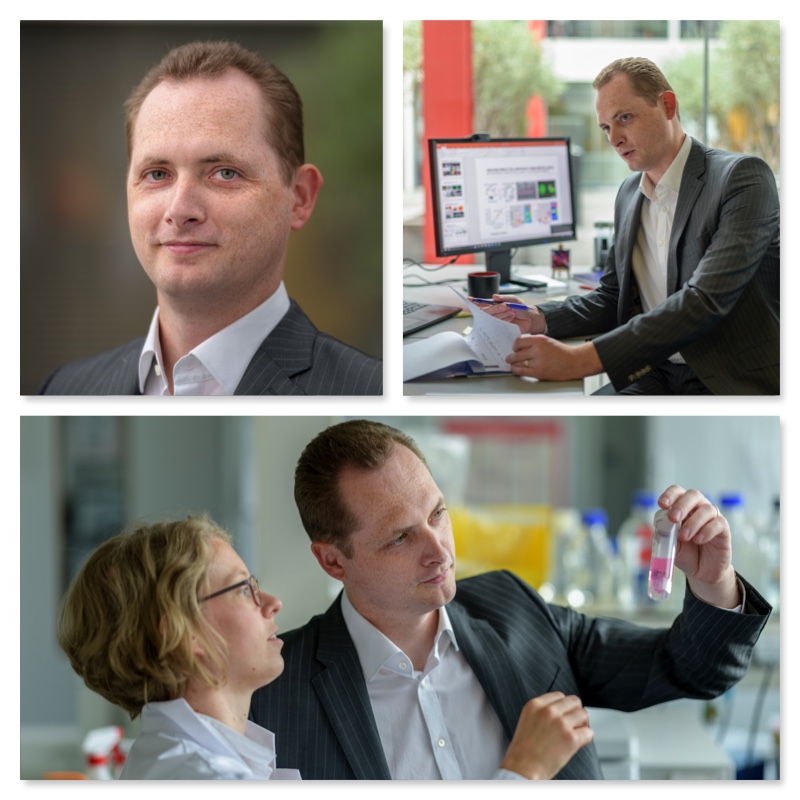Jeroen Leijten advances our ability to engineer organs
“We are close to producing human tissues in the lab, but we are not there yet. Technology is the biggest hurdle to fabricate functional tissues, but we are making great strides,” says Jeroen Leijten, Associate Professor of Complex Tissue Engineering and principle investigator in the Department of Developmental BioEngineering of the TechMed Centre. Leijten’s main focus is to fully understand the functional properties of tissues such as cartilage, bone, muscle, lung, and pancreas in order to develop regenerative engineering strategies to repair tissues that do not heal by themselves.
“In the past decades, we have become very capable in growing and engineering basic tissues. Currently, our main challenge is to make lab-grown tissues fully functional by emulating their native designs. Our natural tissues possess a hierarchical structure, which is crucial to their function. We are trying to replicate these structures using micro- and nano-technologies,” Leijten explains. Eventually, this could even lead to the development of lab grown organs. Although we know this is a realistic goal, it is still exceptionally challenging to achieve. Because, despite the fact that we are already capable of making tissues, engineered tissues do not function as well as their mature natural counter parts due to their oversimplified organisation.
“There are three types of tissue,” says Leijten. “the first is flat tissue, for example skin, which we can recreate relatively well. The second type is hollow tissue. That includes blood vessels, for instance. We can now engineer blood vessels, make a simple bypass graft and this works well too. But creating vascular trees within tissues remains tricky. Tissue engineering can contribute to solving this challenge, but this requires substantial financial investment.
Besides the high costs, Leijten points out other difficulties. “The third type of tissue is solid: this could be your brain, bones, liver or kidney. It is much more complex to recreate those. You would need multiple tissues at the right place and they need to be integrated with each other as well as the whole bodily system. If you engineer an organ, you need a blood vessels network to provide the implant access to the patient’s blood, which keeps the implant alive. Furthermore, the tissues should be innervated, compatible with the immune system, and able to function for decades within the human body. In short, a remaining key challenge is: how do we connect engineered organs to the human body?”
Besides these future challenges, Leijten’s current work concentrates on the clinical application of his work. “If you understand what causes the deterioration of tissues, you can also reproduce ‘diseased tissues’, which can be used to test medications. We work closely with clinicians and patient associations to discuss the technologies and fundamental research which is needed most to develop practical solutions.”
A recent example is a project for which Leijten was awarded a Vidi-grant. The scientist will use this grant to set up a research team to develop a smart biological ink that can easily imitate important tissue structures. “This is an important part of my current research, because organs made in the laboratory could heal or replace worn out organs of patients”, concludes Leijten.
Research and Education
Leijten consistently uses his research in the classes he teaches. “I have the privilege of teaching a course in my own specialty, tissue engineering. Another advantage is that this Master-course is the last course these students take before their internship and graduation. This enables me to accurately predict the potential of the class and to combine all the theories they have been taught. By combining this knowledge, I can help them to develop a better understanding of the matter. It is one thing to memorize formulas, the students need to understand how they can put these formulas to practical use in the real world. This is what they learn in my course.” Besides teaching, the associate professor also mentors PhD-students. “Guiding students to become fully independent researchers, coaching them and seeing how they personally develop is a rewarding role that I enjoy very much.”
About Jeroen Leijten
Jeroen Leijten earned his Master’s degree in studied Biomedical Sciences at Leiden University. He then worked as a PhD-student at University Twente, the Netherlands, in the department of Tissue Engineering under the supervision of professors Clemens van Blitterswijk and Marcel Karperien. The largest accomplishment of his predoctoral research was the unraveling of the question why healthy articular cartilage is resistant to hypertrophic differentiation, which prevents endochondral bone formation and osteoarthritis. This research has yielded indispensable insights in basic biology, joint pathology, and skeletal tissue engineering.
Subsequently, he trained as a postdoctoral researcher at:
- Twente University, The Netherlands, under Prof. Marcel Karperien where I have developed microfabrication techniques and fabricated novel microfluidic devices to generate micromaterial for the creation of multiscale hierarchical tissue constructs;
- KU Leuven, Belgium, under Prof. Frank Luyten, where I have explored microfabrication techniques to investigate the effect of micro-organoid formation of periosteal derived stem cells for skeletal tissue engineering application;
- Harvard-MIT, USA, under supervision of Prof. Ali Khademhosseini where I have led my own subgroup, which focused on the development of responsive biomaterial based 3D microenvironments to steer the stem cell behavior.
Currently, prof. Jeroen Leijten is an Associate Professor at University Twente. His research focuses on the development of nano- and microscale tools using enabling technologies to drive the generation of multiscale bioengineered constructs for skeletal tissue-engineering applications. These developments are expected to yield unparalleled control over biomaterial architectures and cellular behavior. Specifically, he is developing cutting edge technological platforms for the generation of micromaterials that enable the fabrication of multiscale hierarchical tissue constructs that control stem cell behavior at the nano, micro, and macro scale.
Press Photos
These press photos can be used without copyright restrictions.


